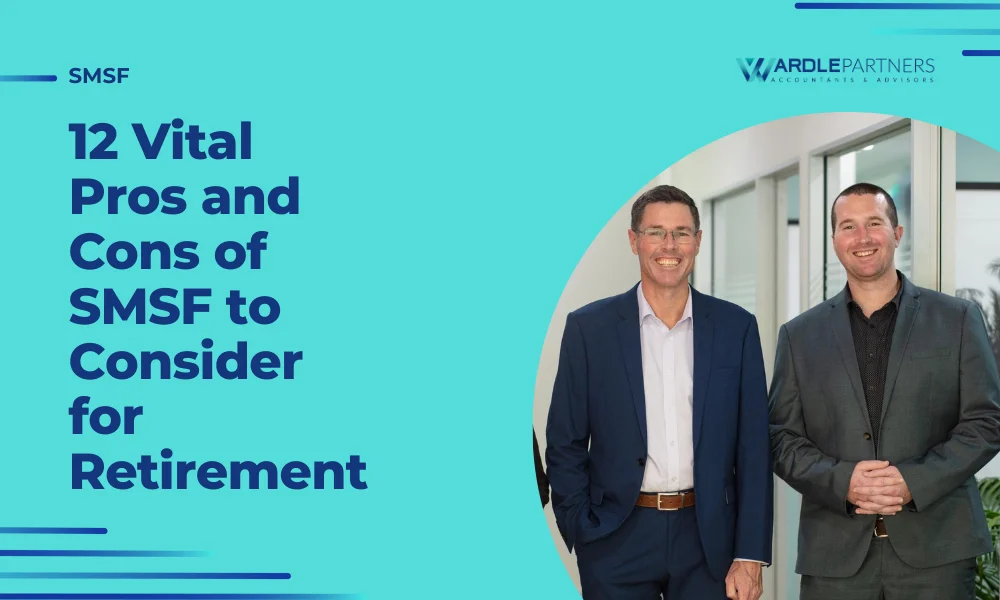What are the Pros and Cons of SMSF to consider for retirement?

Knowing the pros and cons of SMSF is a fundamental step in responsible financial planning. Self-managed super funds (SMSFs) have become a popular choice for Australians looking to take control of their retirement savings. However, understanding the advantages and disadvantages of SMSFs, as well as how they compare to other superannuation funds, is vital for making an informed decision. This article explores the various pros and cons of SMSF.
How Pros and Cons of SMSF Can Guide You Through Retirement
Pros of SMSFs
Control: Members have direct control over investment decisions tailored to their specific financial goals.
Flexibility: SMSFs offer a wide variety of investment options, allowing for a personalised investment strategy.
Tax Efficiency: With careful planning, an SMSF can be an efficient structure for tax purposes, enabling strategies to minimise tax liabilities.
Transparency: Members have a clear view of where and how their money is invested, and can directly manage those investments.
Cost Efficiency: Depending on the fund size and investment choices, an SMSF can be a cost-effective way to manage retirement savings.
Estate Planning: SMSFs offer flexibility in estate planning, ensuring that the member’s wishes are carried out in the event of their death.
Ability to Borrow: Whilst a SMSF is generally prohibited from borrowing, there is an exception throw the use of an associated bare trust. Such borrowings add a lot more risk and complexity to the operation of the SMSF and is generally more expensive than traditional lending arrangements outside of superannuation. It is highly recommended Professional Assistance is obtained before embarking on this benefit.
Cons of SMSFs
Time and Complexity: Managing an SMSF demands significant time and expertise, including understanding SMSF Compliance & Regulations.
Costs: Initial set up costs to outlay ranging from $2,000 to $10,000 depending on complexity and with the aid of Professional Assistance. Running costs may be comparatively high for SMSFs with small balances. Estimated annual running consists are as follows:
- Australian Tax Office (ATO) SMSF Supervisory Levy – $259.
- Financial Adviser – being a “Self Managed Superannuation Fund” it is not compulsory to engage the services of a financial planner to advise on and/or manage the SMSF investments. The fees to do so will vary depending how much advice is sort, complexity of investments, how much is invested and other specific matters such as pension strategy.
- Financial Statement, Income Tax Return Preparation and auditor facilitation – from $2000 for a fund with few investments and transactions and generally ranges up in combination with the complexity of the investments.
- Audit – generally $500 to $1000.
- Insurance for members – not compulsory and depends on the members’ personal circumstances and sum insured.
- Legal fees – generally, it is important the SMSF Deed is in line with current legislation. Some lawyers charge a small fee around $100 to have the Deed upgraded by them each time there is important legislative changes.
- Property expenses – when property is owned.
- GST – paying GST where the Trustees choose or are required to be registered – eg leasing commercial property. If Professional Assistance is obtained to calculate and lodge GST obligations allow from between $250 and $1000 p.a. (depending on annual or quarterly lodgement requirements).
Compliance Risks: Failure to comply with regulations such as the Understanding the Sole Purpose Test and following the terms of the Deed can lead to heavy penalties.
Investment Risks: Greater responsibility for investment decisions means more risk, especially without diversification.
Lack of Protection: Unlike other super funds, SMSFs do not offer the same level of protection if fraud or theft occurs.
Comparison Between SMSFs and Other Types of Superannuation Funds
| FEATURE | SMSFs | OTHER SUPERANNUATION FUNDS (such as retail, industry, or corporate funds) |
| Control | High: Full control and flexibility over investment decisions. | Limited: Controlled by fund managers. |
| Investment Options | Wide range, including Borrowing Within an SMSF using an associated Bare Trust. | Standardised investment options. |
| Costs | Because there are certain base annual running costs such as accounting, audit and ATO fees, depending on complexity they tend to be somewhat similar across different size funds. As a % of the value of the SMSF, can be low for larger balances but high for smaller balances. |
Typically lower for small superannuation balances, but higher for larger balances where the superannuation fund calculates fees as a % of the value. The fee structure might differ based on the type of fund |
| Compliance | Complex: Must adhere to SMSF Compliance & Regulations. | Simplified: Managed by fund managers. |
| Protection | No specific protections for fraud or theft. | Government and industry protections. |
| Time | Requires active management, keeping up to date with legislative changes, and engaging Professional Assistance | Passive: Managed by fund managers. |
| Focus on Retirement Planning | Depends on the person. Will vary from superannuation being something that is hardly ever considered, to having an active interest, following fund performance and where allowed, setting the superannuation asset classes. | Because there are certain base annual running costs such as accounting, audit, and ATO fees, depending on complexity they tend to be somewhat similar across different size funds. As a % of the value of the SMSF, can be low for larger balances but high for smaller balances. |
Conclusion
An SMSF offers a personalised approach to retirement planning, with extensive control and flexibility. However, it also demands time, skill, and rigorous adherence to regulations. Evaluating the pros and cons of SMSF is a critical step in making responsible financial decisions. It equips individuals with the information needed to determine if an SMSF is the right choice for their financial circumstances, goals, and risk tolerance. This informed approach is essential for achieving financial stability and security in retirement.
As a CPA accounting firm in Caloundra QLD Australia, Wardle Partners Accountants and Advisers have been specialising in SMSF set-ups, administration, processing, compliance advice, accounting, taxation, and wind-ups for over 40 years. Please note that the above information is general in nature; and for personalised advice tailored to your specific situation, we recommend consulting with an appropriately licensed financial adviser.
By providing the pros and cons of SMSF overview, we hope to provide valuable insights for those considering this path for retirement planning. The linkages to other blogs within this series offer a more in-depth understanding of related topics, forming a comprehensive guide for SMSF management. If you have any questions or need professional assistance, feel free to contact us or schedule a free consultation with one of our SMSF experts.
Did You Know?
As at 30 June 2022, according to Australian Taxation Office statistics, SMSFs represent over $869 billion in assets and make up a substantial 26% of the total superannuation market in Australia.





